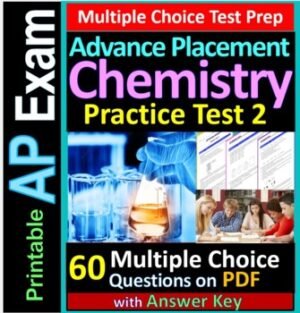Description
~Essential Skills Lesson #39~ Organize sets of easy-to-understand guided reading, engaging example problems with step-by-step solutions, and practice multiple choice and short answer questions related to:
Potential Energy Diagrams; Interpreting, Drawing, and Completing Diagrams, Potential Energy Measurements, Exothermic and Endothermic Curves, Effect of a Catalyst.
With this lesson your student will learn key vocabulary terms and facts, and
develop knowledge and problem-solving abilities in many, if not all of the essential chemistry skill areas listed below.
✔ Vocabulary terms and definitions
✔ Concept related facts
✔ Recognize and identify
✔ Describe, state and compare
✔ Explain and justify. Set up and calculate.
✔ Draw, complete, and interpret diagrams, tables and graphs
✔ Use the Reference Tables
✔ Answering multiple choice questions
✔ Answering constructive response questions
Student and Teacher-friendly Format
✔ Organized sets of guided reading, example and practice questions in each lesson.
✔ Emphasis on a small number of related chem concepts
✔ A nice mix of straightforward and challenging questions
✔ Understandable for students of all skill levels
✔ Small number of pages for a quick read for students, and quick printing and photocopying for teachers
✔ Quick and easy grading for teachers
JUST RIGHT for:
✔ One class period read and practice work
✔ One or two nights homework assignment
Some questions require the use of NYS Chemistry Reference Tables 2011 Edition . Click to access and download.
Bundle Up to Save:
61 Essential Skills Worksheets + 61 Essential Skills Lessons Ultimate Bundle
Essential Skills Worksheets Super Bundle
Essential Skills Guided Lessons Super Bundle (individual lessons are listed below)
Grab another essential skill lesson for your students:
Topic 1 Bundle: Matter, Energy and Change
Lesson 1: Types and Classification of Matter .
Lesson 2: Phases of Matter and Temperature .
Lesson 3: Heat and Heat Calculations
Lesson 4: Characteristics of Gases and Gas Law Calculations
Lesson 5: Physical and Chemical Properties and Changes
Topic 2 Bundle: The Periodic Table
Lesson 6: Properties and Arrangement of the Periodic Table
Lesson 7: Types and Properties of Elements. Metals, Nonmetals, Metalloids, Halogens, Noble Gases
Topic 3 Bundle: Atomic Structure
Lesson 9: History of Atomic Models
Lesson 10: Structure of an Atom, Atomic Mass, Isotopes
Lesson 11: Arrangement of Electrons
Lesson 12 : Neutral Atoms and Ions
Topic 4 Bundle: Chemical Bonding
Lesson 13: Stability and Energy in Bonding
Lesson 14: Types of Chemical Bonds
Lesson 15: Types and Properties of Substances
Lesson 16: Polarity, Shapes and Intermolecular Forces
Lesson 17: Electron-dot Diagrams
Topic 5 Bundle: Chemical Formulas and Equations
Lesson 18: Types of Chemical Formulas
Lesson 19: Chemical Nomenclature
Lesson 20: Types of Chemical Reactions and Balancing Equations
Topic 6 Bundle: Moles and Stoichiometry
Lesson 21: Mole and Mass Calculations in Formulas
Lesson 22: Percent Composition Calculations
Lesson 23: Mole Calculations in Equations
Lesson 24: Properties of Solutions
Lesson 25: Solubility Factors of Solutions
Lesson 26: Types of Solutions and Solubility Curves
Lesson 27: Molarity and Parts per Million Calculations
Lesson 29: Effect of a Solute on Properties of a Solution
Topic 8 Bundle: Acids, Bases and Salts
Lesson 30: Acid and Base Theories and Definitions
Lesson 31: Acid and Base Indicators and pH
Lesson 32: Reactions of Acids and Bases
Lesson 33: Acid-Base Titration
Lesson 34: Relating H+ Concentration to pH
Lesson 35: Salts and Electrolytes
Lesson 36: Naming and Writing Formulas of Acids
Topic 9 Bundle: Kinetics and Equilibrium
Lesson 37: Reaction Rate, Catalysts and Activation Energy
Lesson 38: Energy in Chemical Reactions
Lesson 39: Potential Energy Diagrams
Lesson 41: Physical Equilibrium
Lesson 42: Chemical Equilibrium and Le Chatelier’s Principle
Topic 10 Bundle: Organic Chemistry
Lesson 43: Properties of Organic Compounds
Lesson 44: Hydrocarbon Compounds
Lesson 45: Functional Group Compounds
Topic 11 Bundle: Redox and Electrochemistry
Lesson 49: Half-reactions: Oxidation and Reduction
Lesson 50: Redox: Oxidation-Reduction Reactions
Lesson 51: Components of Electrochemical cells; Anode, Cathode, Salt Bridge
Lesson 52: Voltaic and Electrolytic Cells
Topic 12 Bundle: Nuclear Chemistry
Lesson 54: Nuclear Chemistry Particles
Lesson 55: Nuclear Decay and Reactions
Lesson 56: Balancing and Writing Nuclear Equations
Lesson 58: Uses and Benefits of Radioisotopes
Topic 13 Bundle: Lab Safety and Measurements
Lesson 59: Lab Safety, Procedures and Equipment










Reviews
There are no reviews yet.